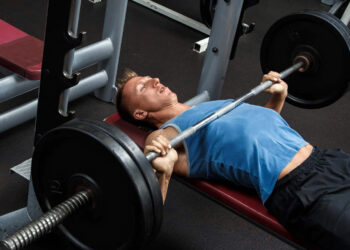Does being short of time stop you from going to the gym as often as you’d like? You are not alone! I’m a veteran personal trainer and the most common excuse I hear for missed workouts is lack of time.
And this is not just my experience; numerous studies also suggest that lack of time is a major barrier to consistent exercise participation (1). The problem is that most people lead busy, fulfilling lives, and when time is short, workouts are often relegated to the back burner.
Unfortunately, missed workouts won’t help you get fitter, stronger, leaner, or more muscular. In contrast, the more workouts you miss, the slower your progress will be, and you might even start losing your hard-won gains.
That’s because you cannot store fitness, and your body will gradually return to its pre-trained state if you don’t work out consistently. In exercise terms, this is called the “use it or lose it” principle.
The good news is that you don’t actually have to spend all that much time training to maintain your current fitness and strength. And contrary to what many people think, you don’t need hours in the gym to build muscle.
In this article, I share a tried-and-tested 15-minute upper-body dumbbell home workout that’s perfect for busy individuals.
Level Up Your Fitness: Join our 💪 strong community in Fitness Volt Newsletter. Get daily inspiration, expert-backed workouts, nutrition tips, the latest in strength sports, and the support you need to reach your goals. Subscribe for free!
15-Minute Upper-Body Dumbbell Workout
Don’t let a lack of time stop you from building upper-body muscle and strength! All you need is 15 minutes, a workout bench, and a pair of adjustable dumbbells to get in shape at home.
Do this workout 2-3 times per week on non-consecutive days, e.g., Monday, Wednesday, and Friday. Alternate it with a similarly quick lower body workout to develop a strong, athletic physique.
But, before you begin, make sure you get your mind and body ready by warming up properly. Do 3-5 minutes of easy cardio, e.g., jumping rope, followed by dynamic mobility and flexibility exercises for your elbows and shoulders.
Warmed up and ready to go? Then let’s begin!
| Exercise | Duration* | |
| 1 | Incline Dumbbell Flye | 3 minutes |
| 2 | Renegade Push-Up and Row | 3 minutes |
| 3 | Decline Dumbbell Pullover | 3 minutes |
| 4 | Alternating Front and Side Raise | 3 minutes |
| 5 | Dumbbell Hammer Curl and Press | 3 minutes |
*For this workout, forget all about conventional sets and reps. Instead, you’re going to work for a prescribed time.
Pick a weight you can lift 10-12 times and then rep out to failure. Rest for 15-20 seconds and pump out a few more reps. Continue until the allotted time has expired. Move straight onto the next exercise and repeat.
This method is called rest-pause training and is a proven strength and hypertrophy system (2).
Related: How to Maintain Muscle During a Layoff
Exercise Instructions
You’ll get better results from your workouts if you perform every exercise correctly. Good technique means more tension for your muscles and less stress on your joints, making every rep you do safer and more effective. Follow these step-by-step instructions and watch the videos to make sure you’re doing each exercise properly.
1. Incline Dumbbell Flye
Target muscles: Pectoralis major, anterior deltoids.
Incline dumbbell flyes are one of the best exercises for targeting your upper chest. They also work your anterior or front deltoids. Doing an isolation exercise at the start of your workout might seem like an odd choice but this sequencing will pre-fatigue your chest, making the next exercise much more challenging and effective.
Steps:
- Set your bench to a 30-degree angle.
- Sit on your bench and press your dumbbells up to arm’s length over your shoulders. Your palms should face inward, i.e., a neutral grip.
- Bend your arms slightly but then keep them rigid throughout your set.
- Open your arms and lower the dumbbells out to the side until you feel a stretch across your chest.
- Squeeze your arms back up and together.
- Continue until failure, rest 15-20 seconds, and then crank out a few more reps. Repeat this sequence for three minutes.
Pro Trainer Tips:
- Pause for 2-3 seconds at the bottom of each rep to increase time under tension and the difficulty of your workout.
- Do not lower the dumbbells too far down as doing so could lead to shoulder pain.
- Make sure you squeeze rather than press the weight back up and together to avoid using too much triceps strength and taking work away from your pecs.
2. Renegade Push-Up and Row
Target muscles: Pectoralis major, latissimus dorsi, trapezius, rhomboids, deltoids, biceps, triceps.
If you only have time to do one upper body exercise today, the renegade push-up and row should be it. Working virtually every muscle in your upper body, this exercise is a no-brainer for time-pressed lifters. It also delivers a free core workout, adding even more value to this challenging movement.
Level Up Your Fitness: Join our 💪 strong community in Fitness Volt Newsletter. Get daily inspiration, expert-backed workouts, nutrition tips, the latest in strength sports, and the support you need to reach your goals. Subscribe for free!
Steps:
- Hold a dumbbell in each hand, squat down, and adopt the push-up position. Your hands should be roughly shoulder-width apart, palms facing inward.
- Bend your arms and lower your chest down between your hands.
- Extend your arms and then row one dumbbell up into your lower ribs.
- Return the weight to the floor and do a similar row with the other arm.
- Continue this push-up/row/row sequence until failure.
- Rest for 15-20 seconds, and then crank out a few more reps. Repeat this sequence for three minutes.
Pro Trainer Tips:
- Elevate your feet on a bench or step to make this exercise more challenging.
- Lead with your elbows during the rows and keep your upper arms close to your side to increase latissimus dorsi recruitment.
- Descend slowly into each push-up but drive up dynamically to maximize muscle engagement.
3. Decline Dumbbell Pullover
Target muscles: Latissimus dorsi, pectoralis major, triceps.
Despite being an isolation exercise, pullovers provide a very comprehensive upper-body workout that targets your pecs, lats, and triceps. Because of this, bodybuilding expert Arthur Jones called the pullover, “the upper body squat.” Decline pullovers keep your muscles under constant tension, making them superior to the flat bench version.
Steps:
- Set your exercise bench to a 10 to 20-degree decline.
- Lie on your bench and hold a dumbbell above your chest with two hands.
- Keeping your elbows slightly bent, lower the weight back and behind your head as far as your flexibility allows. Get a good stretch in your lats.
- Pull the dumbbell back up and over your chest.
- Continue until failure, rest 15-20 seconds, and then crank out a few more reps. Repeat this sequence for three minutes.
Pro Trainer Tips:
- Pause in the stretched position to increase time under tension and make this exercise more challenging.
- You can also do dumbbell pullovers with two weights instead of one.
- No decline bench? Simply place some blocks under one end of your exercise bench.
4. Alternating Front and Side Raise
Target muscles: Anterior deltoids, medial deltoids.
While your deltoids or shoulder muscles are involved in virtually every upper body exercise, they’ll still benefit from some more targeted training, which is where your next exercise comes in. Where front raises emphasize your anterior deltoids, side raises target the lateral head. This exercise will help develop those coveted 3D shoulders you’ve always dreamed of.
Steps:
- Stand with your feet about shoulder-width apart, knees slightly bent.
- Hold a dumbbell in each hand with your palms facing your thighs. Keep your elbows slightly bent but rigid throughout.
- Raise your arms forward and up to shoulder height.
- Lower your arms and then lift them up and out to the side, again to shoulder height.
- Lower your arms again and repeat this front/side raise sequence until failure.
- Rest for 15-20 seconds, and then crank out a few more reps. Repeat this sequence for three minutes.
Pro Trainer Tips:
- Rotate your pinkie finger slightly upward to increase muscle engagement during the side raise part of this exercise.
- Do two side raise reps to every front raise if you want to emphasize your medial deltoids.
- Pause at the top of each rep to make this exercise more challenging. Shorten the pause as your muscles begin to tire.
5. Dumbbell Hammer Curl and Press
Target muscles: Biceps, forearms, deltoids, triceps.
Your final exercise is another time-saving twofer. By combining hammer curls with overhead presses, you hit your biceps, forearms, and triceps while providing your deltoids with another great workout. Do this exercise seated or standing as preferred. However, do not use your legs or back to help you lift the weights. Stop and rest if you feel your form starting to deteriorate.
Steps:
- Hold a dumbbell in each hand with your arms by your sides and palms facing inward.
- Bend your arms and curl the weights up to your shoulders.
- Next, press your dumbbells up and overhead to arm’s length.
- Lower the weights smoothly back to your shoulders and down to your sides.
- Continue until failure, rest 15-20 seconds, and then crank out a few more reps. Repeat this sequence for three minutes.
Pro Trainer Tips:
- You can also do this exercise with an underhand grip for the curls.
- Use an alternating arm action if you prefer.
- Keep your chest up and your shoulders down and back throughout – no slouching.
Cardio Solutions for Time-Pressed Exercisers
If a lack of time prevents you from lifting weights, I expect you think that you don’t have time for cardio, either. And while it’s true that going for a long run or bike ride will probably be impractical, you should still be able to find a few minutes for a quick HIIT workout.
So, because cardio is so important, I recommend ending your 15-minute dumbbell upper body workout with some Tabata jump rope, sprints, or burpees.
Tabata training involves doing eight sets of 20 seconds of work alternated with 10 seconds of rest. This comes to just four minutes, so it won’t add much extra time to your workout. However, research indicates that this is long enough to boost fitness and burn fat (3).
Don’t be fooled; despite their brevity, Tabata intervals are incredibly challenging. However, it’s their high intensity that makes up for the lack of duration.
Conclusion
While being short of time is a legitimate barrier to exercise, it’s not insurmountable. With a little effort, energy, and organization, you can have an effective workout at home in less time than most people spend warming up.
That’s not to say this is the perfect way to work out, and short training times will limit your gains. However, any workout is better than no workout, so don’t let the pursuit of perfection get in the way of building muscle and strength.
The key to time-efficient workouts is a) keeping things simple and b) plain old hard work. Use this 15-minute upper body workout to score some gains even if you are too busy to get to the gym.
References:
- Hoare E, Stavreski B, Jennings GL, Kingwell BA. Exploring Motivation and Barriers to Physical Activity among Active and Inactive Australian Adults. Sports (Basel). 2017 Jun 28;5(3):47. doi: 10.3390/sports5030047. PMID: 29910407; PMCID: PMC5968958.
- Oliver JM, Jagim AR, Sanchez AC, Mardock MA, Kelly KA, Meredith HJ, Smith GL, Greenwood M, Parker JL, Riechman SE, Fluckey JD, Crouse SF, Kreider RB. Greater gains in strength and power with intraset rest intervals in hypertrophic training. J Strength Cond Res. 2013 Nov;27(11):3116-31. doi: 10.1519/JSC.0b013e3182891672. PMID: 23736782.
- Tabata I. Tabata training: one of the most energetically effective high-intensity intermittent training methods. J Physiol Sci. 2019 Jul;69(4):559-572. doi: 10.1007/s12576-019-00676-7. Epub 2019 Apr 19. PMID: 31004287; PMCID: PMC10717222.









